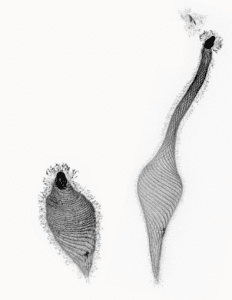TAG: GS 3: SCIENCE AND TECHNOLOGY
THE CONTEXT: Stanford researchers, driven by curiosity and “recreational biology,” have made a groundbreaking discovery in the field of cellular behavior.
EXPLANATION:
- They have identified a form of complex behavior in a single-cell organism, Lacrymaria olor, that mimics the principles of origami, without the involvement of a nervous system.
- This discovery has profound implications for understanding cellular mechanics and geometry in biology.
Lacrymaria olor
- An associate professor of bioengineering at Stanford University and his graduate student spent seven years studying Lacrymaria olor.
- Their fascination began with observing the organism through a paper Foldscope.
- This free-living protist, shaped like a teardrop, exhibits a remarkable behavior: it extends a long, thin “neck” up to 1,500 microns from its 40-micron body, then retracts it seamlessly.
- This is akin to a 6-foot human extending their head over 200 feet.
Form and Function: The Mechanism Behind Cellular Origami
- Lacrymaria olor’s behavior is not only mesmerizing but also complex, given that it lacks a nervous system.
- It was discovered that the organism’s behavior is dictated by its cytoskeletal structure, specifically thin, helical microtubules that function similarly to the principles of traditional origami.
- This phenomenon, termed “cellular origami” or “lacrygami,” involves a subset of origami known as “curved-crease origami.”
Cytoskeletal Structure and Geometry
- Using transmission electron microscopy, the researchers identified 15 stiff, helical microtubule ribbons encasing the cell membrane, forming a cytoskeleton.
- These tubules coil and uncoil, enabling the cell to extend and retract its neck in a controlled manner.
- The membrane tucks neatly inside the cell in well-defined pleats, demonstrating a sophisticated geometric control.
- The unfolding and refolding process of Lacrymaria olor is mathematically precise.
- It involves a singularity, or a d-cone, where the structure simultaneously folds and unfolds, acting as a controller.
- This geometric mechanism ensures that the cell’s behavior is consistent and flawless, even after 50,000 cycles of extension and retraction.

A side-by-side comparison of Lacrymaria olor, a remarkable ciliate with its “neck” extended and retracted
Implications and Practical Applications
- The discovery of cellular origami opens new avenues for biotechnological advancements.
- The development of deployable microscale “living machines,” can potentially revolutionise fields like space technology and medical robotics.
- These machines could be designed to mimic the precise and reliable folding mechanisms observed in Lacrymaria olor.
SOURCE: https://phys.org/news/2024-06-cellular-origami-protist.html
Spread the Word
